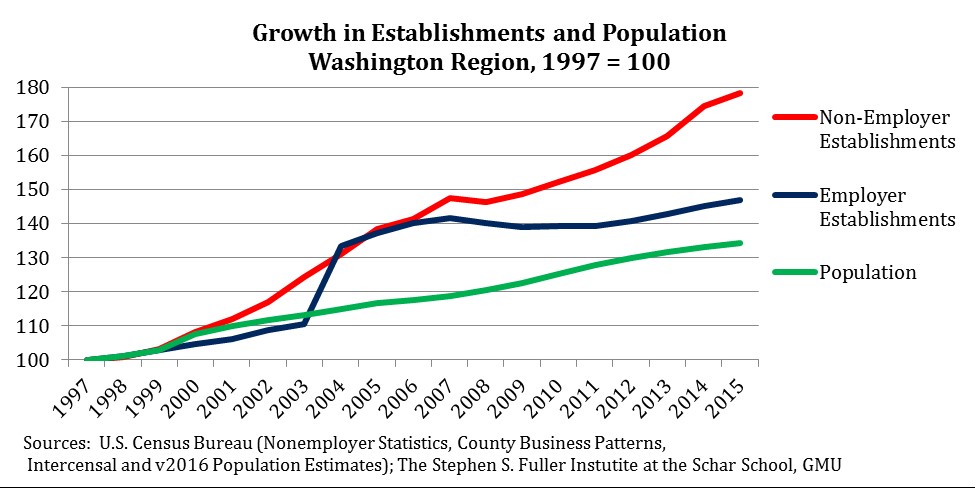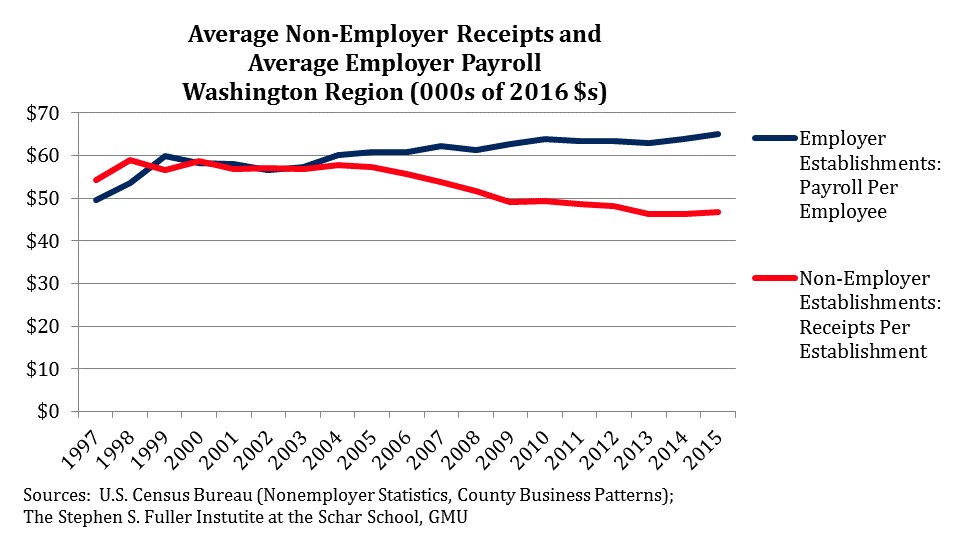By Ellen Harpel, President, Business Development Advisors, and Jeannette Chapman, Deputy Director and Senior Research Associate at The Stephen S. Fuller Institute
This is the first of three blogs covering this report. In this blog, we look at the major trends in non-employer establishment growth over time. In the second blog, we compare these trends in the Washington region with its peer metros. In the third blog, we look at the types of work being performed by non-employer establishments in the region.
Download the full report as a PDF>>
Work in today’s economy is conducted in many different ways. It increasingly does not involve a wage or salary job, a single boss, or employment with a company. We are familiar with anecdotal evidence of this trend, including our own experiences with the gig economy, but it is difficult to quantify using the data that we generally rely upon for economic analysis. Payroll jobs, the traditional measure of employment, may no longer be sufficient to tell us how work is performed or what is being done by whom in our regional economy.
Non-employer establishment statistics are one supplemental source that gives us some more insight into this phenomenon in the Washington region. These data suggest that the gig economy, self-employed and freelance workers, and independent contractors play a sizable role in the Washington regional economy.
What Are Non-Employer Establishments? These establishments have no paid employees, have annual business receipts of at least $1,000, and are subject to federal income tax.[1] Non-employer businesses “include a mix of solopreneurs, freelancers, passive businesses, hobby businesses, and even corporations”[2] as well as some gig economy workers and independent contractors.
What’s Happening in the Washington Region?
The number of non-employer establishments has been growing rapidly in the Washington region. The number of non-employer establishments increased from 295,000 in 1997 to 526,000 in 2015, a 78.4 percent increase. By comparison, employer establishments, the more traditional measure of wage and salary employers, increased 46.9 percent during the same period. Similarly, non-employer establishments grew more quickly than the Washington region’s population, which increased only 34.4 percent between 1997 and 2015.

Since 1997, non-employer establishments have been significantly more numerous than establishments with employees. In 1997, there were 102,000 private sector employer establishments and nearly three (2.9) times as many non-employer establishments. The fast growth in non-employer establishments increased this difference and in 2015 there were 3.5 non-employer establishments for every establishment with employees. Put another way, 77.8 percent of all establishments did not have wage and salary employees in 2015.
While non-employer establishments grew significantly faster than employer establishments, the growth in the number of workers associated with each was more closely matched. Non-employers, by definition, do not have wage and salary employees, so a worker at an establishment is the individual owner/worker, meaning there is one implied worker at each establishment. Jobs in private sector employer establishments are counted directly and increased from 1.6 million to 2.6 million between 1997 and 2015, a 62.8 percent increase. The number of implied workers in non-employer establishments increased at a somewhat faster rate, rising 78.4 percent. Overall, the proportion of non-employers owners to employees at employer establishments has stayed fairly consistent at around 14-17 percent.
Non-employer establishments do not have payrolls and, instead, business receipts are reported. The business receipts reflect the maximum income that the owner/worker of the establishment could earn. Because most establishments will also have expenses – gas and car depreciation value for an Uber or Lyft driver, office space for a full time business consultant – the receipts per establishment over-estimate the likely effective wage for the owner.
Between 1997 and 2003, the receipts per non-employer establishment and the average payroll (i.e. wage) of employees at traditional private sector firms were nearly equal, at around $57,000 in 2016 dollars for most of the period. In 2004, this pattern shifted and the average wage for workers in traditional jobs increased modestly while average non-employer receipts decreased. This divergence may mark a rise in part-time work through non-employer establishments.

In 2015, the average receipts in a non-employer establishment were $46,770 in 2016 dollars, 20.7 percent lower than its peak in 1998. However, an equal decrease occurred nationally (-20.8%), suggesting a more fundamental change in the types of work conducted using non-employer establishments. The rise of the gig economy, especially during and after the Recession, accelerated the growth in non-employer establishments, but lowered the average receipts.
About These Data
All non-employer statistics are from the U.S. Census Bureau’s Nonemployer Statistics Datasets. Employer statistics are from the U.S. Census Bureau’s County Business Patterns. For all metro areas, the 2013 metropolitan statistical definitions were used, aggregating from the county-level files. National data are from the United States files for both the non-employer statistics and county business patterns.
[1] Census Bureau, https://www.census.gov/programs-surveys/nonemployer-statistics/about/glossary.html
[2] Small Business Labs, June 4, 2015. http://www.smallbizlabs.com/2015/06/23-million-nonemployer-businesses-in-2013.html
